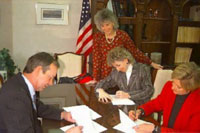Election 2000 - How "we" Elect The President - Aaron Rogers |
| November 7, 2000 when over 90 million Americans cast their vote for the next President of the United States do they know that they are not directly electing the President? On December 18th (the first Monday after the second Wednesday in December), when the 538 citizens of the Electoral College cast their votes, a new President will be elected. The American people's votes suposedly instruct these electors how to vote. The funny thing is that there is no language in the Constitution forcing them to do so. The Electoral College system was established in Article II of the Constitution and amended by the 12th Amendment in 1804. We don't know for sure why our Founding Fathers constructed it the way they did, but it seems that among the three choices for electing the President: through Congress, the people, or electors, the Electoral College seemed the lesser of all evils. Winston Churchill exclaimed, "the electoral college system is probably the worst possible method of choosing a President - except for all the others."
One interesting thing to note: Before the 12th Amendment was adopted, the electors voted for two persons without differentiating between a vote for President and Vice President. The highest number of votes, if it was a majority, elected the President. If there was a tie for first place, the House of Representatives, each state voting separately, chose among the candidates. If there was no majority, the House was required to choose among the five candidates who received the most votes. Then, the candidate with the second most votes was elected the Vice President, even if that person was not of the same party as the President. The Senate would make a selection in case of a tie. Today, each state gets a number of electors equal to its number of members in the House of Representatives plus one for each of its two Senators. The District of Columbia gets three electors. In most cases, a state's laws determine the selection process of its electors, although they are usually chosen by political conventions, in primary elections, or by party organizations. Each elector gets one vote; 270 of the 538 are necessary to elect a President. Oddly enough, it is possible for a President to lose the popular vote and yet still win the election. In fact, this has happened twice; once in 1876 (Rutherford B. Hayes) and again in 1888 (Benjamin Harrison). Usually this happens when electors go against who they are "supposed" to vote for. There is nothing in the Constitution which requires them to do so, but some states have enacted laws against this practice of "defection." It is also possible for a candidate to win 11 of the 12 most-represented states, lose the other 39, and still win the election. If no candidate receives the majority of electoral votes,the House of Representatives must elect the President. Every state gets only one vote which the majority of its representatives decides upon. The Senate elects the Vice President by choosing among the two candidates who received the most votes. This has only occurred twice; 1801 (Thomas Jefferson) and 1825 (John Quincy Adams). The worth of the Electoral College has been heatedly discussed for some time. Regardless of the margin of victory a candidate has in a state, the victor still receives all of the state's electoral votes. Another problem can occur if a candidate fails to win the majority of all the electors' votes. The vote for the President, by the House of Representatives, and for the Vice President, by the Senate, might take a lengthy period of time, they could easily choose two leaders from opposing parties. These are not worries of the past, these are issues that can affect any election. If the vote is as close as it's been recently, pay close attention to what happens. |

